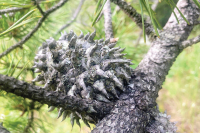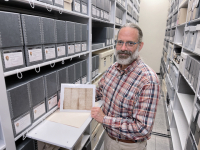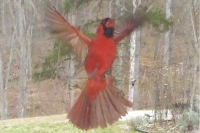Some ‘Indian Caves’ were very likely the real thing
 Everywhere you go in Western North Carolina there are secluded places reputed to have been used as hideaways by the 500 or so Cherokees seeking refuge during the removal era of the late 1830s. Most of these legends are oft-told tales connected to dank holes in the ground.
Everywhere you go in Western North Carolina there are secluded places reputed to have been used as hideaways by the 500 or so Cherokees seeking refuge during the removal era of the late 1830s. Most of these legends are oft-told tales connected to dank holes in the ground.
In point of fact, caves were not favored by the Cherokee as shelters even during the removal. They preferred overhanging rock shelters they were familiar with from centuries of upland hunting.
To be sure, they sought out secluded nooks away from the main routes, but they also wanted a dry site that offered good water and warming sunlight, especially during the long winter of 1838-1839.
The complex of so-called “Indian Caves” and the adjacent rock shelter in the Nantahala Gorge meet those criteria. But they may not have been used because of the proximity of Fort Lindsay at the mouth of the Nantahala River.
Tsali’s Rock on the Left Fork of Deep Creek in the high Smokies under Clingmans Dome is the most famous shelter, and may indeed have been the actual spot where the Cherokee martyr Tsali was apprehended. But as a shelter it’s not very impressive, consisting of an overhanging rock maybe 15-feet high that would provide dry quarters for not more than four adults.
One of the most impressive sites is the shelter at Rockhouse Knob in the Nantahala Mountains about 10 miles southwest of Franklin (“Prentiss NC” topo map). The top of the mountain is covered in thick rhododendron, but the southwest face consists of an extensive granite outcrop that forms a vertical wall several hundred yards long and well over 100-feet high in places.
Related Items
The first portion of the outcrop provides little, if any, shelter. The southern end, however, separated from the main wall long ago creating a room-like space about 150-feet long, 50-feet wide, and 150-feet high.
The overhanging cliff keeps out precipitation while allowing afternoon sunlight to strike and warm the granite interior. One portion of the “room” sits high and dry, while a lower portion contains a spring. A round fireplace of stones maintained by hikers and hunters may well be situated where the old campfires of the early Cherokee hunters were placed.
There can be little doubt that the Cherokee knew the site. It’s too good for them to have missed, and it’s situated near one of the trails that led from their towns in present north Georgia to the Nantahala settlements and those on the Valley River near present Murphy.
The alleged use of Rockhouse Knob during the removal is not far-fetched, even if absolute documentation is probably impossible. The southern Nantahalas were a remote, rugged area that the Indians knew well. The region was also away from the network of forts and stockades constructed by the U.S. Army.
North Georgia native Beatrice Jefferson Stubbs, in a chapter titled “This Was Indian Country” in her 1986 volume Views from Valley Front, recalled that the Dillard, Ga., settlers “took pity on the plight of the refugees” and “supplied grain and other necessities over a period of years, or until it was legally safe for the Indians to appear in public.”
The spring 1989 issue of “Foxfire” magazine contains an article titled “The Cherokee Cave,” with photographs of the the shelter. The student authors interviewed “Doctor” John M. Brown, an area resident, who was told as a child about the existence of the Rockhouse by two older woodsmen.
“I was taken to it by great uncle Jim Williams,” Brown recalled. “The story narrates that three Indians occupied the shelter ... during the time that it was illegal for Cherokee to remain in these mountains. Furthermore, these Indians were thought to be members of Wayah Katoga’s family.”
It seems unlikely the Rockhouse Knob site would have gone unused during that sad period. There is — to my knowledge — no natural upland shelter in Western North Carolina better suited for that sort of extended refuge.
Readers can contact George Elison at P.O. Box 1262, Bryson City, N.C., 28713, or at This email address is being protected from spambots. You need JavaScript enabled to view it..













